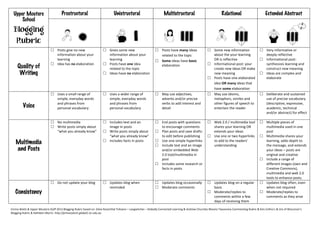Blogging Rubric
- 1. Upper Moutere School Blogging Rubric Prestructural  Unistructural  Multistructural  Relational  Extended Abstract       Quality of Writing ÂĢïĢ Posts  give  no  new  information  about  your  learning   ÂĢïĢ Idea  has  no  elaboration  ÂĢïĢ Gives  some  new  information  about  your  learning  ÂĢïĢ Posts  have  one  idea  related  to  the  topic  ÂĢïĢ Ideas  have  no  elaboration  ÂĢïĢ Posts  have  many  ideas  related  to  the  topic  ÂĢïĢ Some  ideas  have  basic  elaboration    ÂĢïĢ Some  new  information  about  the  your  learning  OR  is  reflective   ÂĢïĢ Informational  post:  your  create  new  ideas  OR  make  new  meaning  ÂĢïĢ Posts  have  one  elaborated  idea  OR  many  ideas  that  have  some  elaboration   ÂĢïĢ Very  informative  or  deeply  reflective  ÂĢïĢ Informational  post:  synthesizes  learning  and  construct  new  meaning   ÂĢïĢ Ideas  are  complex  and  elaborate  Voice ÂĢïĢ Uses  a  small  range  of  simple,  everyday  words  and  phrases  from  personal  vocabulary    ÂĢïĢ Uses  a  wider  range  of  simple,  everyday  words  and  phrases  from  personal  vocabulary    ÂĢïĢ May  use  adjectives,  adverbs  and/or  precise  verbs  to  add  interest  and  detail    ÂĢïĢ May  use  idioms,  metaphors,  similes  and  other  figures  of  speech  to  entertain  the  reader    ÂĢïĢ Deliberate  and  sustained  use  of  precise  vocabulary  (descriptive,  expressive,  academic,  technical  and/or  abstract)  for  effect    Multimedia and Posts ÂĢïĢ No  multimedia  ÂĢïĢ Write  posts  simply  about  âwhat  you  already  knowâ  ÂĢïĢ Includes  text  and  an  image  in  posts  ÂĢïĢ Write  posts  simply  about  âwhat  you  already  knowâ  ÂĢïĢ Includes  facts  in  posts   ÂĢïĢ End  posts  with  questions  to  encourage  comments  ÂĢïĢ Plan  posts  and  save  drafts  to  edit  before  publishing  ÂĢïĢ Use  one  simple  hyperlinks  ÂĢïĢ Include  text  and  an  image  and/or  embedded  Web  2.0  tool/multimedia  in  post  ÂĢïĢ Includes  some  research  or  facts  in  posts    ÂĢïĢ Web  2.0  /  multimedia  tool  shares  your  learning  OR  extends  your  ideas  ÂĢïĢ Use  one  or  two  hyperlinks  to  add  to  the  readersâ  understanding   ÂĢïĢ Multiple  pieces  of  multimedia  used  in  one  post  ÂĢïĢ Multimedia  shares  your  learning,  adds  depth  to  the  message,  and  extends  your  ideas  â  posts  are  original  and  creative  ÂĢïĢ Include  a  range  of  different  images  (own  and  Creative  Commons),  multimedia  and  web  2.0  tools  to  enhance  posts.  Consistency ÂĢïĢ Do  not  update  your  blog  ÂĢïĢ Updates  blog  when  reminded  ÂĢïĢ Updates  blog  occasionally  ÂĢïĢ Moderate  comments   ÂĢïĢ Updates  blog  on  a  regular  basis   ÂĢïĢ Moderate/replies  to  comments  within  a  few  days  of  receiving  them  ÂĢïĢ Updates  blog  often,  even  when  not  required  ÂĢïĢ Moderate/replies  to  comments  as  they  arise   Emma  Watts  &  Upper  Moutere  Staff  2013  Blogging  Rubric  based  on:  Silvia  Rosenthal  Tolisano  â  Langwitches  â  Globally  Connected  Learning  &  Andrew  Churches  Blooms  Taxonomy  Commenting  Rubric  &  Kim  Cofinoâs  &  Uni  of  Wisconsinâs  Blogging  Rubric  &  Kathleen  Morris   http://primarytech.global2.vic.edu.au   Â
- 2. Upper Moutere School Blogging Rubric Prestructural  Unistructural  Multistructural  Relational  Extended Abstract       Presentation (Blog Design) ÂĢïĢ Uses  the  basic  blog  theme  from  setting  up  blog  ÂĢïĢ Choose  a  basic  theme  that  is  easy  to  navigate  ÂĢïĢ Includes  labels  for  students  OR  learning  areas  ÂĢïĢ Include  an  about  page  ÂĢïĢ Include  a  search  box  and  links  ÂĢïĢ Use  fonts  and  dark  coloured  text  that  is  easy  to  read  ÂĢïĢ Include  a  number  of  pages  with  static  information  e.g.  guidelines,  websites,  parent  information  ÂĢïĢ Include  some  third  part  widgets  (e.g.  ClustrMaps)  ÂĢïĢ Include  an  email  subscription  ÂĢïĢ Use  a  theme  that  is  clear,  well  designed  and  easy  to  customize  ÂĢïĢ Revise  pages  regularly  to  ensure  info  is  up-Ââto-Ââdate  ÂĢïĢ Customize  your  theme  with  images  and  backgrounds,  layout  etc.  ensuring  blog  is  still  easy  to  navigate  and  read  ÂĢïĢ Limit  âfunâ  widgets  to  not  take  a  way  from  posts  and  speed  up  loading  time   Digital Citizenship ÂĢïĢ Uses  copyrighted  images  ÂĢïĢ Use  own  images  and  copyrighted  images  ÂĢïĢ Keep  YAPPY  information  safe  (your  full  name,  address,  phone  number)  ÂĢïĢ Beginning  to  Creative  Commons  materials  ÂĢïĢ Developing  netiquette:  respecting  the  viewpoints  of  all  readers  and  commenters  ÂĢïĢ Understands  and  is  beginning  to  use  netiquette:  respect  the  viewpoints  of  all  readers  and  commenters  ÂĢïĢ Often  uses  Creative  Commons  materials  and  beginning  to  use  correct  attributions.  ÂĢïĢ Consistently  uses  netiquette  ÂĢïĢ Consistently  use  Creative  Commons  materials  with  correct  attributions.  ÂĢïĢ Cite  all  sources  of  information  Community ÂĢïĢ No  labels  (tags)  on  post  ÂĢïĢ Label  (tag)  some  posts  ÂĢïĢ Label  (tag)  most  posts  ÂĢïĢ Label  (tag)  all  posts   ÂĢïĢ Contains  links  to  other  blogs,  websites  or  PDFs  to  help  the  readerâs  understanding  ÂĢïĢ Contains  links  to  other  blogs,  websites  or  PDFs  to  help  the  readerâs  understanding  ÂĢïĢ Links  are  relevant  ÂĢïĢ All  posts  are  labeled  Comments ÂĢïĢ Read  some  comments  ÂĢïĢ Read  all  comments  ÂĢïĢ Read  all  comments  and  reply  to  comments  with  questions  ÂĢïĢ Begin  to  use  the  letter  format  for  quality  commenting  ÂĢïĢ Read  and  reply  to  all  comments  ÂĢïĢ Compliment  the  writer  ÂĢïĢ Ask  questions  ÂĢïĢ Consistently  follow  the  letter  format  for  quality  commenting  ÂĢïĢ Reply  to  all  comments  and  regularly  ask  commenters  thoughtful  questions  to  generate  further  discussion  ÂĢïĢ Add  new  ideas  and  include  links  to  sources  Collaboration ÂĢïĢ Read  your  own  blog  and  other  class  blogs  within  our  school  ÂĢïĢ Read  your  own  blog,  other  class  blogs  from  your  school,  and  blogs  from  around  the  world  ÂĢïĢ Regularly  read  and  occasionally  comment  on  a  number  of  blogs  from  your  school  and  around  the  world   ÂĢïĢ Regularly  read  and  comment  on  a  number  of  blogs  from  your  school  and  around  the  world  ÂĢïĢ Organise  other  blogs  in  a  blogroll  on  your  blog  ÂĢïĢ Work  together  with  other  educational  bloggers  on  global  collaborative  projects  Â

